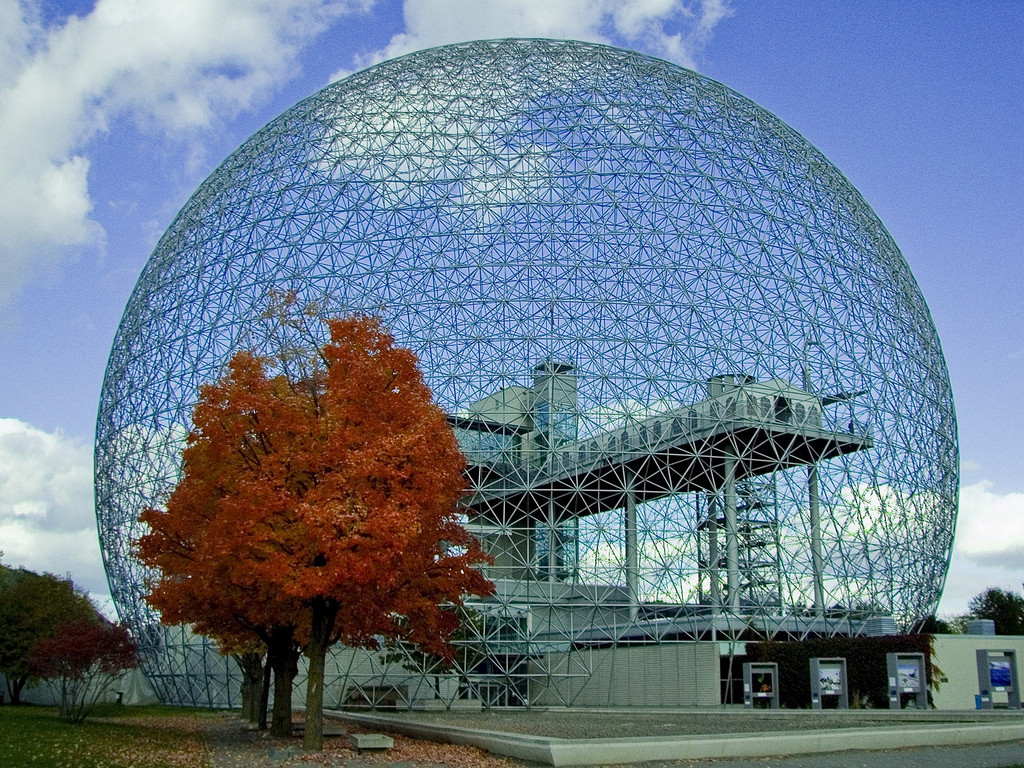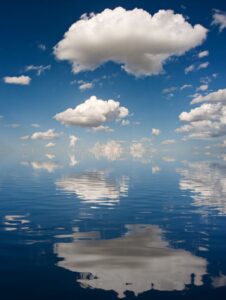It’s intriguing to learn that Buckminster Fuller, one of the most inventive minds ever, had two of his major intuitions while gazing at water. One example:
“In 1917 . . . Buckminster Fuller was watching the bubbles boiled up in the wake of a Navy ship, and concluding from those millions of changing spheres that nature did not use pi. For pi will only describe a sphere once formed, and a sphere moreover idealized because static. But the generation of forms is described by vectors, and Buckminster Fuller proposed to make it his business to find nature’s energetic geometry. Just 50 years later the bubble behind the ship had become in Montreal a geodesic skybreak bubble 20 stories high, enclosing 7 million cubic feet of air, as free as a water bubble of internal supports, and weighing a hundredth of what former technology dictated that such a structure should weigh. The load on its foundations was less than the weight of its materials, and had it been a mile wide it would have floated away.”1

In the Tao Te Ching, the Tao is described as “a river flowing home to the sea” and Meister Eckhart likened God to “a great underground river that no one can dam up and no one can stop.” Alan Watts, in his book, The Way of Zen (p. 99), talks about yun shui (雲水 “cloud” & “water”) “the common and revealingly picturesque term for the Zen student, who drifts like a cloud and flows like water.”

It was a rainbow, that mystical mirage of sunlight and mist, that God chose as symbol to establish his covenant with humankind. Baptism, ablutions and rituals of pouring, sacred rivers such as the Ganges and the Jordan, rain dances, sweat lodges, water spirits in mythology such as nymphs and naiads, the still pool as metaphor for the enlightened mind, the living water that Jesus talks about in John’s Gospel that keeps you from ever thirsting again—Jesus, whose ministry began with his baptism in the river Jordan, whose first disciples were fishermen, whose first miracle was turning water to wine, Jesus, who calms the tempestuous sea and walks on water, who tells us we must be born again, of water and Spirit, who washes the disciples’ feet with water, and whose next to last utterance on the cross is, “I thirst.”
Water, water, everywhere! . . . as Coleridge says in his poem, “Rime of the Ancient Mariner.” “Life is an aquatic phenomenon,” my old biology Prof told us again and again.
We humans are drawn to water for refreshment of body and spirit—just look at how people flock to lakes, rivers, waterfalls, geysers, beaches, the open sea. And the sound of water—how refreshing and soothing: the ocean surf, a babbling mountain stream, gentle rain, a quiet fountain in a peaceful garden . . . is this not music for the soul?
Life on this planet began in water, just as each one of us, with bodies over 70% water, began life in the amniotic fluids of our mother’s womb. Water symbolizes not only the presence of Spirit, but also the activity of Spirit, and, in its many splendid forms, what a beautiful, rich, and endlessly suggestive symbol it is. As Bucky Fuller’s example shows, the contemplation of water can cause revolutionary intuitive ideas to bubble up from our own watery depths.
We would do well to often dwell in the evocative presence of water in all its myriad forms, water in stillness, waters in tempest, water in flow, the morning dew, bubbling springs—sustaining, refreshing, cleansing . . . speaking from the depths.
____________________
1. Hugh Kenner, The Pound Era, pp. 161-62.
HyC